For the past 17 years, a lone spacecraft has been following Earth’s tracks in its orbit around the Sun and capturing unprecedented views of our host star. Now, STEREO-A has finally caught up with its home planet, lapping us in our cosmic trail and meeting the Earth for a brief rendezvous.
On Saturday, NASA’s STEREO-A spacecraft is scheduled for its first Earth flyby since its launch on October 25, 2006, the space agency revealed. The flyby is not only a chance for the spacecraft to reunite with Earth, but also provides a rare opportunity for STEREO-A to collaborate with other NASA missions to view the Sun in new and exciting ways.
The STEREO (Solar TErrestrial RElations Observatory) mission actually started off with twin spacecraft: the leading STEREO-A (for ahead) and STEREO-B, which lagged behind. The two spacecraft provided the first stereoscopic, or multiple-perspective, view of the Sun. At some point, the spacecraft even achieved a 180 degree separation from each other in their orbits, giving us a simultaneous view of the star as a complete sphere for the first time.
“Prior to that we were ‘tethered’ to the Sun-Earth line – we only saw one side of the Sun at a time,” Lika Guhathakurta, STEREO program scientist at NASA, said in a statement. “STEREO broke that tether and gave us a view of the Sun as a three-dimensional object.”
In 2014, STEREO-B sadly went silent after a planned reset, and STEREO-A was forced to go solo. During its upcoming flyby, however, STEREO-A will once again work as part of a team. The spacecraft will synthesize its views with the Solar and Heliospheric Observatory (SOHO), a joint mission between NASA and the European Space Agency, as well as NASA’s Solar Dynamics Observatory (SDO).
The collaboration between the solar missions will allow for a multi-perspective view of the Sun, or stereoscopic vision. It’s similar to how our brains compare images from each eye and use differences between those images to differentiate between closer and farther objects, creating depth perception. The data gathered by the three missions will allow scientists to gather three-dimensional information that would otherwise be lost in two-dimensional images of the Sun.
The team of scientists behind the STEREO mission are also hoping to test a theory about coronal loops, curved arcs of the magnetic field that pops up through the visible surface of the Sun. “There is a recent idea that coronal loops might just be optical illusions,” Terry Kucera, STEREO project scientist at NASA’s Goddard Space Flight Center, said in a statement. “If you look at them from multiple points of view, [the answer] should become more apparent.”
During the months before and after Saturday’s flyby, STEREO-A will also be hit by the plumes of solar material that are directed towards Earth, and will measure those coronal mass ejections (CMEs). As the solar material travels from the Sun towards Earth, it will hit STEREO-A as well as SOHO and SDO. Prior to this flight, coronal mass ejections have only been felt by one spacecraft at a time.
“It’s like the parable about the blind men and the elephant—the one who feels the legs says ‘it’s like a tree trunk,’ and the one who feels the tail says ‘it’s like a snake,’” Toni Galvin, a professor at the University of New Hampshire and principal investigator for one of STEREO-A’s instruments, said in a statement. “That’s what we’re stuck with right now with CMEs, because we typically only have one or two spacecraft right next to each other measuring it.”
The last time the STEREO spacecraft was close to Earth in 2006, the Sun was in its solar minimum, or the point during its 11-year cycle with low activity. The Sun is now approaching its solar maximum, and the star has been quite lively as of late. Earlier this week, two massive solar flares erupted from the Sun and disrupted radio signals in the U.S.
“In this phase of the solar cycle, STEREO-A is going to experience a fundamentally different Sun,” Guhathakurta said. “There is so much knowledge to be gained from that.”
For more spaceflight in your life, follow us on Twitter and bookmark Gizmodo’s dedicated Spaceflight page.

